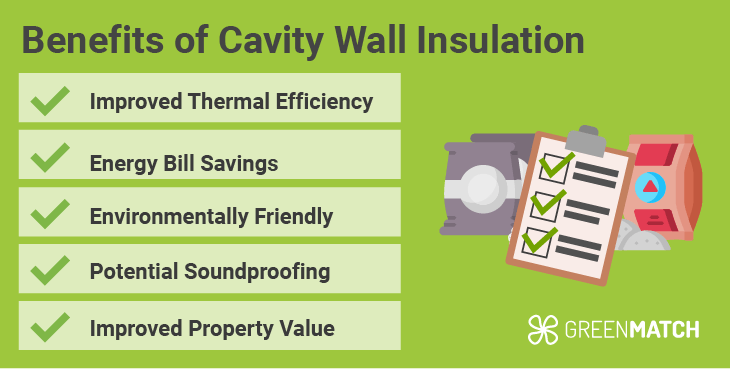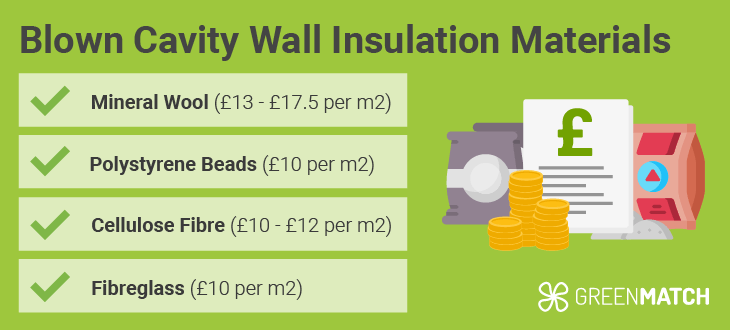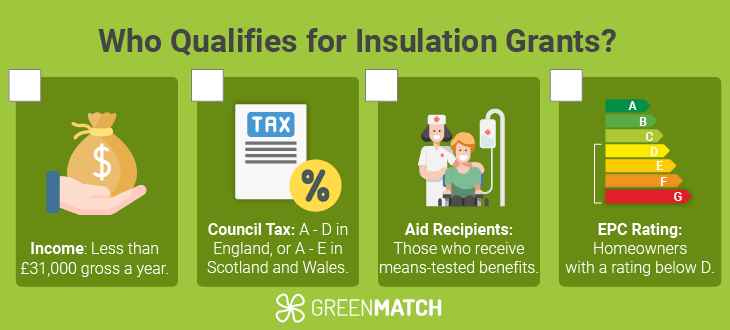Answer these simple questions and we will find you the BEST prices
Which type of solar quotes do you need?
It only takes 30 seconds
100% free with no obligation

Get Free quotes from insulation specialists near you

Save money by comparing quotes and choosing the most competitive offer

The service is 100% free and with no obligation
- GreenMatch
- Insulation
- Blown In Insulation
- Blown Cavity Wall Insulation
Blown Cavity Wall Insulation: A UK Guide

- Uninsulated cavity walls are responsible for up to 33% of heat loss in a home, leading to hiked energy bills and a huge domestic carbon footprint.
- Insulating cavity walls in a standard UK detached home can save you up to £370 in annual energy bills.
- Blown cavity wall insulation options are made from several materials, including mineral wool, EPS polystyrene beads, cellulose and fibreglass.
Cavity walls are commonly found throughout the UK, making up nearly three-quarters of all properties. These walls consist of an inner and outer wall with a cavity or space in between to prevent moisture ingress. However, this cavity space should also be insulated to boost your home’s thermal efficiency.
A popular method of insulating cavity walls is through blown in insulation, which consists of a group of materials such as mineral wool, fibreglass, cellulose, and EPS polystyrene beads. This complete guide by GreenMatch UK will give you everything you need to know to make the right choice for your household.
Ready to get cavity wall insulation? Let GreenMatch UK solve all your problems. Through our nationwide network of pre-vetted installers, we can send you up to 3 free home-tailored quotes completely free of charges and obligations. Click the button below to begin!
Fill in the form in just 1 minute
What is blown cavity wall insulation?
Blown cavity wall insulation fills the hollow space between your home's exterior walls with loose-fill insulation material. Here’s how the installation process takes place:
- A qualified blown insulation installer first drills small, evenly spaced holes into your exterior walls to create access to the cavity space in between.
- The installer then uses professional industry equipment to blow the insulation into the cavity space.
- The small holes drilled in the outer wall are then patched up with cement for a seamless finish, leaving your home’s facade without visible changes.
The entire process of cavity insulation takes only 1 - 2 hours, is non-invasive, and will leave your home's facade completely unchanged, making it a highly efficient means of insulating your walls.
Is blown cavity wall insulation a good idea?

While the initial investment for cavity wall insulation may seem hefty, blown cavity wall insulation has plenty of benefits that justify the price tag. Here are just some of the key perks you can expect to enjoy:
- Improved thermal efficiency: Insulating your cavity walls reduces home heat loss by up to 33%. This leads to less use of your heating system, a well-maintained indoor temperature, moisture control and peace of mind.
- Energy bill savings: Just in a standard detached UK house, proper cavity wall insulation can save you up to £370 in annual energy bills, year on year. This means you can also pay back your investment in just over ten years.
- Environmentally friendly: Uninsulated homes are responsible for significant carbon emissions. By insulating your walls, you can cut carbon emissions by 1,100 kgCO2 per year in a standard UK detached house.
- Potential soundproofing: While thermal insulation material is not designed for soundproofing, it can improve noise reduction compared to uninsulated cavity walls, making your home environment more peaceful.
- Improved property value: By properly insulating your walls, your property becomes more thermally efficient and thus more demandable on the housing market. Fully insulated houses generally observe an increase in their market value.
Beyond the basics, you may be wondering just how much you could potentially save with cavity wall insulation. Take a look at the average annual savings per home type in the UK and in Northern Ireland:
| Home type | Energy bill savings England (£/year) | Energy bill savings Northern Ireland (£/year) |
|---|---|---|
| Flat/Apartment | £100 | £140 |
| Mid terrace home | £130 | £175 |
| Semi-detached home | £210 | £300 |
| Detached bungalow | £160 | £225 |
| Detached home | £370 | £520 |
Types of blown cavity wall insulation

Several blown insulation materials on the market are suited for cavity wall insulation. Each comes with its own price ranges, pros, cons, and properties worth considering.
Regardless, all blown insulation materials are installed in the same manner; by a professional using industry equipment to inject material into the cavity space through drilled holes.
To get a better idea of what insulation material is best suited for your needs, let’s start by first taking a look at each material a bit more in-depth, as well as blown cavity wall insulation cost per m2 of material.
Mineral wool
Mineral wool cavity wall insulation is one of the most popular on the market. Due to its relative affordability, availability and versatility, it makes for a very worthy option. Costing an affordable £13 - £17.5 per m2. Mineral wool is usually made from rock or glass and can be found as batts of blankets, or as loose fill used for blown in insulation, such as for cavity walls. Rockwool cavity wall insulation tends to perform better than glass.
Mineral wool also exhibits an impressive r-value range of around 2.5 - 3.3 m²K/W depending on the opted density of the material, with rockwool cavity insulation on the higher end of the spectrum. It is also hydrophobic, meaning it does not absorb water and is even flame and smoke-resistant.
Polystyrene beads
EPS polystyrene beads are highly effective small spheres of polystyrene that have taken the insulation market by storm. These cavity wall insulation beads have highly impressive thermal capabilities, durability, and resistance to weathering making them a great long-term choice for blown cavity wall insulation.
With an r-value of 2.6 - 3.3 m²K/W, EPS polystyrene beads cost around £10 per m2 of material. They are also moisture, flame and smoke resistant, making them a safe household choice.
As a downside, EPS polystyrene is a synthetic material that can release harmful fumes during production but can also be recycled into new polymer products after use.
Cellulose fibre
Cellulose is perhaps one of the most sustainable and environmentally friendly blown fibre insulation options available on the market today. Made from recycled paper and wood products, cellulose only costs around £10 - £12 per m2, but boasts an impressive r-value of 2.4 - 2.8 m²K/W, making it a quite effective insulator.
As a downside, cellulose does not boast the same hydrophobic properties as some previously mentioned materials due to being composed of paper and wood, but as an advantage, cellulose does not produce harmful off-gassing during or after installation.
Fibreglass
Fibreglass, much like mineral wool, can be found as batts of blankets or as loose-fill insulation to be injected into cavity walls. Made from recycled glass, it is relatively sustainable and disposable after use.
Fibreglass costs around £10 per m2, but boasts an r-value range of 2.2 - 4.3 m²K/W, giving it an impressive cost-to-thermal efficiency balance.
What is the best-blown cavity wall insulation?
The best-blown cavity wall insulation will depend on several factors, such as what a customer considers the best qualities for an insulation material.
For those looking for the cheapest blown cavity wall insulation material, then options such as fibreglass emerge as a great option. Alongside its smaller price tag, it still boasts an impressive r-value and moisture-resistant qualities.
For those looking for the most sustainable blown cavity wall insulation material, then cellulose is likely your best bet. It may not be as impressive in its properties, but it is entirely produced from recycled paper and wood waste, fully non-toxic, and can be recycled with ease.
For the most thermally efficient blown cavity wall insulation material, EPS polystyrene beads stand out as the top contender. With their high r-value, durable properties and robustness, polystyrene beads can provide sustained thermal comfort to a home for decades.
Costs of blown cavity insulation
According to Energy Saving Trust UK, the average cost of blown cavity fill insulation for a standard UK detached house is around £4,600 for a full job, including materials and labour costs. However, this cost can vary depending on the type of property you have, and the insulation material you opt for.
Below is a summary of the average costs of a full cavity wall insulation per property type:
| Home type | Average insulation costs |
|---|---|
| Flat/Apartment | £1,000 |
| Mid terrace home | £1,500 |
| Semi-detached home | £2,700 |
| Detached bungalow | £2,100 |
| Detached home | £4,600 |
Grants for blown cavity insulation

While cavity wall insulation, or wall insulation in general, tends to be more expensive than other home insulation upgrades, there’s a big chance you can get some assistance on the cost with some cavity wall insulation grants!
Luckily, the UK government has launched two key grant schemes to help fuel-poor, low-income, and energy-inefficient households with home insulation upgrades. These are the Great British Insulation Scheme (GBIS) and the Energy Company Obligation (ECO4).
Both home insulation grant schemes prioritise homeowners and renters who fall into the low-income group. Some indicators of those who belong in this bracket are:
- Income: In the UK, households with a gross annual income of less than £31,000 are considered to be low-income. Therefore, these households can qualify for government assistance in upgrading their home's thermal efficiency.
- Council tax: A household's council tax band range can identify financial stability as well. Council tax bands are used to determine how much council tax you pay based on the value of your property. Homes in bands A - D in England, and A - E in Scotland and Wales can qualify for grants from either scheme.
- Aid recipients: Both homeowners and renters who qualify for means-tested benefits by the UK government can qualify as low-income individuals. These are benefit schemes provided by the UK government and cover a range of assistance, such as pension credit, job seekers allowance, or child allowance.
In addition, the Energy Performance Certificate (EPC) rating of a house can be a factor in whether you qualify or not for assistance. An EPC rating tells you how energy efficient your home is, rated from A (most efficient) to G (least efficient). Homeowners with an EPC rating below D can generally qualify for assistance.
Deciding to insulate your cavity walls is a great step, but the real struggle is finding the right blown cavity wall insulation installers near you. With the endless choices, researching and vetting each company can have you stuck in an endless loop with no bargain in sight for insulating your home. Luckily, GreenMatch UK can help you out.
Simply fill in our 30-second online form, and we’ll send you up to 3 free home-tailored quotes straight from our nationwide network of professionals. The best part? Our services are completely free of charges and obligations. Click the button below to begin!
Fill in the form in just 1 minute
FAQ
Blown cavity wall insulation is a great way to boost your home’s energy efficiency, cutting your heat loss by up to 33%, improving your home’s energy efficiency, and comfort; even saving you up to £370 in annual energy bills for a standard detached home.
Your overall investment for cavity wall insulation will hinge on several factors, such as your chosen material, home size, existing insulation and more. On average, cavity wall insulation for a standard detached home in the UK costs around £4,600 for a full job.
There is no “bad” type of cavity wall insulation, but rather a bad installation that can lead to problems. Whilst some materials like cellulose may not exhibit the best resistance to damage, or others like polystyrene cavity wall insulation may be synthetic, a poor installation can quickly become a burdensome repair job in no time if installed unprofessionally. Work with a professional accredited installer to avoid your investment going to waste.
Blown cavity wall insulation is installed by a professional. They first drill a series of small holes in your home’s outer walls to create access to the cavity space. Then, professional equipment is used to inject the insulation material into the cavity. Finally, the small holes are sealed up with cement for a seamless finish that leaves the facade of your home unchanged. The entire process takes no longer than 1-2 hours.
EPS polystyrene beads are one of the most effective and thermally efficient cavity wall insulation materials on the market, however, like any material, they come with their cons worth considering. Cavity wall insulation polystyrene beads problems include the fact that they are synthetic polymers that are non-biodegradable and not environmentally friendly to produce. They can also dislodge from their bonding in the cavity space to create gaps that can accrue moisture.

Akif is a copywriter at GreenMatch since 2023. With a keen interest in community sustainability, green solutions and the role of digital media in identifying climate trends, he aims to hone in on his background in International Studies and Digital Media to provide a multidisciplinary approach to written content rooted in credible research and accuracy.
We strive to connect our customers with the right product and supplier. Would you like to be part of GreenMatch?

